A) 0.63.
B) 1.16.
C) 1.60.
D) 2.27.
F) All of the above
Correct Answer

verified
Correct Answer
verified
Multiple Choice
Which of the following consumer goods and services is most like to suffer declining sales during a recession?
A) haircuts.
B) ground beef.
C) toothpaste.
D) restaurant meals.
F) C) and D)
Correct Answer

verified
Correct Answer
verified
Multiple Choice
The government is most likely to block a proposed merger between two companies when:
A) the cross-elasticity between the companies' products is positive and large.
B) the cross-elasticity between the companies' products is negative and large.
C) the income elasticity of the companies' products is positive.
D) the income elasticity of the companies' products is negative.
F) None of the above
Correct Answer

verified
Correct Answer
verified
Multiple Choice
If a union argues that a price cut will boost revenues of the firm and management argues that the opposite is true, then the price elasticity of demand is:
A) unit-elastic from the union's perspective and unit-inelastic from management's perspective.
B) perfectly inelastic from the union's perspective and perfectly elastic from management's perspective.
C) elastic from the union's perspective; inelastic from management's perspective.
D) inelastic from the union's perspective; elastic from management's perspective.
F) A) and C)
Correct Answer

verified
Correct Answer
verified
Multiple Choice
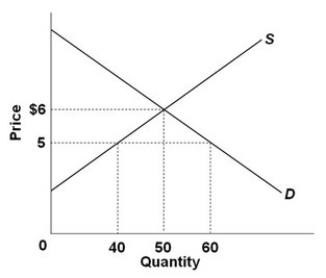 Refer to the graph above. Over the $5-$6 range, the elasticity of supply using the midpoints formula is:
Refer to the graph above. Over the $5-$6 range, the elasticity of supply using the midpoints formula is:
A) 0.22.
B) 0.88.
C) 1.00.
D) 1.22.
F) A) and B)
Correct Answer

verified
Correct Answer
verified
Multiple Choice
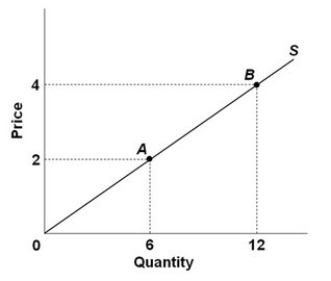 - Refer to the figure above. What is the price elasticity of supply between points A and B above?
- Refer to the figure above. What is the price elasticity of supply between points A and B above?
A) -1
B) 1/3
C) 1
D) 2
F) All of the above
Correct Answer

verified
Correct Answer
verified
Multiple Choice
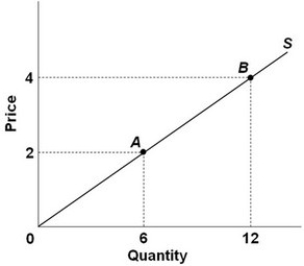 - Refer to the figure above. The elasticity of supply for a product will be 2 when:
- Refer to the figure above. The elasticity of supply for a product will be 2 when:
A) a 1 percent decrease in the price causes a 0.2 percent decrease in quantity supplied.
B) a 2 percent decrease in price causes a 1 percent decrease in quantity supplied.
C) a 1 percent decrease in price causes a 2 percent decrease in quantity supplied.
D) a 2 percent decrease in price causes a 2 percent decrease in quantity supplied.
F) A) and B)
Correct Answer

verified
Correct Answer
verified
Multiple Choice
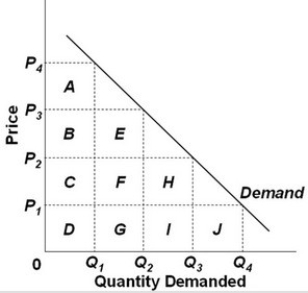 - Refer to the graph above and assume that the areas of the boxes are the same. Consider a situation where price increases from P3 to P4. In this price range, demand is relatively:
- Refer to the graph above and assume that the areas of the boxes are the same. Consider a situation where price increases from P3 to P4. In this price range, demand is relatively:
A) inelastic because the loss in total revenue (areas E + F + G) is greater than the gain in total revenue (area A) .
B) elastic because the loss in total revenue (areas E + F + G) is greater than the gain in total revenue (area A) .
C) elastic because the loss in total revenue (area A) is greater than the gain in total revenue (areas E + F + G) .
D) inelastic because the loss in total revenue (area A) is greater than the gain in total revenue (areas E + F + G) .
F) A) and C)
Correct Answer

verified
Correct Answer
verified
Multiple Choice
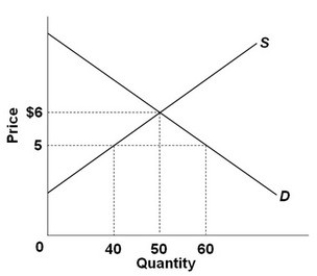 Refer to the figure above. Over the $5-$6 range, the elasticity of demand using the midpoint formula is:
Refer to the figure above. Over the $5-$6 range, the elasticity of demand using the midpoint formula is:
A) 0.22.
B) 0.88.
C) 1.00.
D) 1.16.
F) B) and C)
Correct Answer

verified
Correct Answer
verified
Multiple Choice
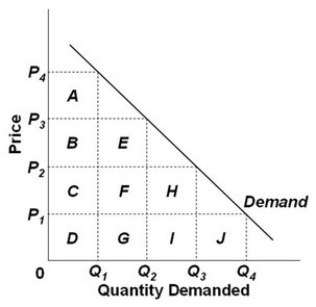 - Refer to the graph above and assume that the areas of the boxes are the same. Consider a situation where price decreases from P2 to P1. In this price range, demand is relatively:
- Refer to the graph above and assume that the areas of the boxes are the same. Consider a situation where price decreases from P2 to P1. In this price range, demand is relatively:
A) inelastic because the loss in total revenue (areas D + G + I + J) is greater than the gain in total revenue (areas C + F + H) .
B) elastic because the loss in total revenue (areas C + F + H) is greater than the gain in total revenue (area J) .
C) elastic because the loss in total revenue (area J) is less than the gain in total revenue (areas C + F + H) .
D) inelastic because the gain in total revenue (area J) is less than the loss in total revenue (areas C + F + H) .
F) A) and C)
Correct Answer

verified
Correct Answer
verified
Multiple Choice
Those who support legalizing the sale and use of cocaine and heroin argue that:
A) demand is highly inelastic, so legalization would reduce expenditures on drugs and reduce street crime.
B) demand is highly elastic because there are so many substitutes for these drugs.
C) addict demand is inelastic, but the demand by occasional users is elastic.
D) addict demand is elastic, but the demand by occasional users is inelastic.
F) A) and D)
Correct Answer

verified
A
Correct Answer
verified
Multiple Choice
Those who oppose the legalization of cocaine and heroin argue that:
A) demand is inelastic for both addicts and occasional users.
B) demand is highly elastic for both addicts and occasional users.
C) addict demand is inelastic, but the demand by occasional users is elastic.
D) addict demand is elastic, but the demand by occasional users is inelastic.
F) None of the above
Correct Answer

verified
Correct Answer
verified
Multiple Choice
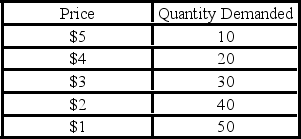 -Refer to the table above. Starting at a $1 price, at what price range does demand become elastic?
-Refer to the table above. Starting at a $1 price, at what price range does demand become elastic?
A) $1-2
B) $2-3
C) $3-4
D) $4-5
F) C) and D)
Correct Answer

verified
Correct Answer
verified
Multiple Choice
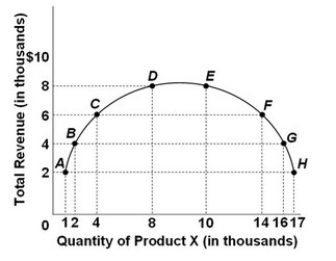 Refer to the above graph. When the quantity of product X sold increases from 8,000 to 10,000, the price elasticity of demand for product X over that range is:
Refer to the above graph. When the quantity of product X sold increases from 8,000 to 10,000, the price elasticity of demand for product X over that range is:
A) elastic.
B) inelastic.
C) unit-elastic.
D) perfectly inelastic.
F) A) and C)
Correct Answer

verified
C
Correct Answer
verified
Multiple Choice
Augi sells 300 cat toys each month when the price is $5 per toy. When Augi lowered the price to $4, she sold 400 toys. The price elasticity of demand over the $4 to $5 range is approximately:
A) 0.78 and elastic.
B) 1.29 and elastic.
C) 0.78 and inelastic.
D) 1.29 and inelastic.
F) A) and C)
Correct Answer

verified
Correct Answer
verified
Multiple Choice
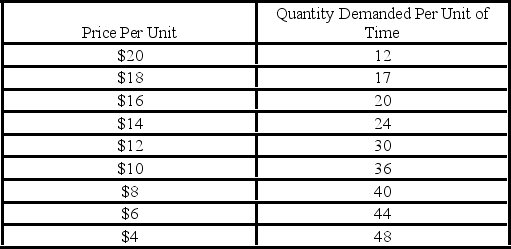 -Refer to the above data. What is the price elasticity of demand over the range of $8 to $10?
-Refer to the above data. What is the price elasticity of demand over the range of $8 to $10?
A) 0.11
B) 0.47
C) 1.93
D) 1.43
F) A) and C)
Correct Answer

verified
Correct Answer
verified
Multiple Choice
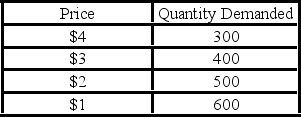 - Refer to the above data. What is the elasticity of demand between the prices of $4 and $3?
- Refer to the above data. What is the elasticity of demand between the prices of $4 and $3?
A) 0.2
B) 0.5
C) 1
D) 2
F) B) and C)
Correct Answer

verified
C
Correct Answer
verified
Multiple Choice
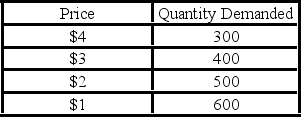 -Refer to the above data. What is the elasticity of demand between the prices of $3 and $2?
-Refer to the above data. What is the elasticity of demand between the prices of $3 and $2?
A) 0.22
B) 0.40
C) 0.56
D) 1.22
F) All of the above
Correct Answer

verified
Correct Answer
verified
Multiple Choice
In some markets consumers may buy many different brands of a product. Which of the statements below best represents a situation where demand for a particular brand would be very elastic?
A) "The different brands are almost identical so I always buy the cheapest."
B) "I use so little of that product that when I do buy it, I don't pay much attention to the price."
C) "The brand I buy is so superior to other available brands that I hardly consider the others."
D) "I pinch pennies in buying other products, but like most people I feel I owe it to myself to get the best brand of this product."
F) All of the above
Correct Answer

verified
Correct Answer
verified
Multiple Choice
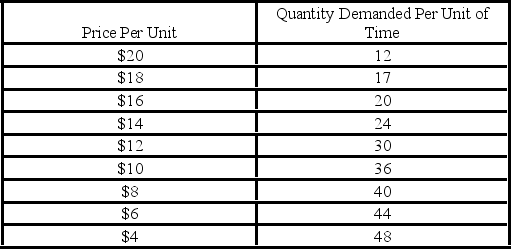 - Refer to the above data. Over which price range is the price elasticity of demand elastic?
- Refer to the above data. Over which price range is the price elasticity of demand elastic?
A) $4-$6
B) $6-$8
C) $10-$12
D) $12-$14
F) All of the above
Correct Answer

verified
Correct Answer
verified
Showing 1 - 20 of 23
Related Exams